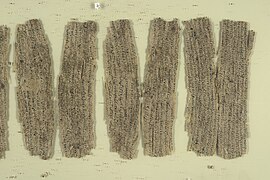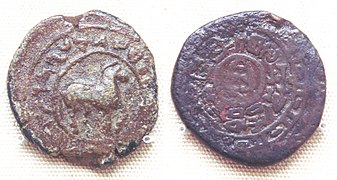Kharosthi
| Kharosthi 𐨑𐨪𐨆𐨮𐨿𐨛𐨁𐨌 | |
|---|---|
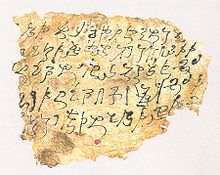 | |
| Script type | |
Time period | 4th century BCE – 3rd century CE |
| Direction | Right-to-left script |
| Languages | |
| Related scripts | |
Parent systems | |
Sister systems | |
| ISO 15924 | |
| ISO 15924 | Khar(305),Kharoshthi |
| Unicode | |
Unicode alias | Kharoshthi |
| U+10A00–U+10A5F | |
| Part ofa serieson |
| Numeral systems |
|---|
| List of numeral systems |
Kharosthi script(Gāndhārī:𐨑𐨪𐨆𐨮𐨿𐨛𐨁𐨌𐨫𐨁𐨤𐨁,romanized:kharoṣṭhī lipi), also known as theGandhari script(𐨒𐨌𐨣𐨿𐨢𐨌𐨪𐨁𐨌𐨫𐨁𐨤𐨁,gāndhārī lipi),[1]was an ancientIndic scriptused by various peoples from the north-western outskirts of theIndian subcontinent(present-dayPakistan) toCentral AsiaviaAfghanistan.[2]Anabugida,it was introduced by the middle of the 3rd century BCE, possibly during the 4th century BCE,[3]and remained in use until it died out in its homeland around the 3rd century CE.[2]
It was also in use inBactria,theKushan Empire,Sogdia,and along theSilk Road.There is some evidence it may have survived until the7th centuryinKhotanandNiya,both cities inEast Turkestan.
History
[edit]
The name Kharosthi may derive from the Hebrewkharosheth,a Semitic word for writing,[4]or fromOld Iranian*xšaθra-pištra,which means "royal writing".[5]The script was earlier also known asIndo-Bactrian script,Kabul scriptandArian-Pali.[6][7]
Scholars are not in agreement as to whether the Kharosthi script evolved gradually, or was the deliberate work of a single inventor. An analysis of the script forms shows a clear dependency on theAramaic alphabetbut with extensive modifications. Kharosthi seems to be derived from a form of Aramaic used in administrative work during the reign ofDarius the Great,rather than the monumentalcuneiformused for public inscriptions.[4]One theory suggests that the Aramaic script arrived with theAchaemenid conquest of the Indus Valleyin 500 BCE and evolved over the next 200+ years to reach its final form by the 3rd century BCE where it appears in some of the Edicts of Ashoka. However, no intermediate forms have yet been found to confirm this evolutionary model, and rock and coin inscriptions from the 3rd century BCE onward show a unified and standard form. An inscription in Aramaic dating back to the 4th century BCE was found inSirkap,testifying to the presence of the Aramaic script in present-day Pakistan. According toSir John Marshall,this seems to confirm that Kharoshthi was later developed from Aramaic.[8]
While the Brahmi script remained in use for centuries, Kharosthi seems to have been abandoned after the 2nd–3rd century AD. Because of the substantial differences between the Semitic-derived Kharosthi script and its successors, knowledge of Kharosthi may have declined rapidly once the script was supplanted by Brahmi-derived scripts, until its re-discovery by Western scholars in the 19th century.[4]
The Kharosthi script was deciphered separately almost concomitantly byJames Prinsep(in 1835, published in theJournal of the Asiatic society of Bengal,India)[9]and byCarl Ludwig Grotefend(in 1836, published inBlätter für Münzkunde,Germany),[10]with Grotefend "evidently not aware" of Prinsep's article, followed byChristian Lassen(1838).[11]They all used the bilingual coins of theIndo-Greek Kingdom(obverse in Greek, reverse inPali,using the Kharosthi script). This in turn led to the reading of theEdicts of Ashoka,some of which were written in the Kharosthi script (theMajor Rock EdictsatMansehraandShahbazgarhi).[4]
The study of the Kharosthi script was recently invigorated by the discovery of theGandhāran Buddhist texts,a set ofbirch bark manuscriptswritten in Kharosthi, discovered near the Afghan city ofHaddajust west of theKhyber PassinPakistan.The manuscripts were donated to theBritish Libraryin 1994. The entire set of British Library manuscripts are dated to the 1st century CE, although other collections from different institutions contain Kharosthi manuscripts from 1st century BCE to 3rd century CE,[12][13]making them the oldest Buddhist manuscripts yet discovered.
Alphabet
[edit]This articleneeds additional citations forverification.(June 2019) |
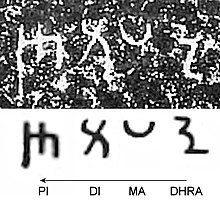
Kharosthi is mostly written right to left. Some variations in both the number and order of syllables occur in extant texts.[citation needed]
The Kharosthi alphabet is also known as the arapacana alphabet, and follows the order.
- a ra pa ca na
- la da ba ḍa ṣa
- va ta ya ṣṭa
- ka sa ma ga stha
- ja śva dha śa kha
- kṣa sta jñā rtha (orha)
- bha cha sma hva tsa
- gha ṭha ṇa pha ska
- ysa śca ṭa ḍha
This alphabet was used inGandharan Buddhismas a mnemonic for thePañcaviṃśatisāhasrikā Prajñāpāramitā Sūtra,a series of verses on the nature of phenomena.
Consonants
[edit]| Unvoiced | Voiced | Nasal | Semivowel | Sibilant | Fricative | |||
|---|---|---|---|---|---|---|---|---|
| Unaspirated | Aspirated | Unaspirated | Aspirated | |||||
| Velar | 𐨐 k IPA:/k/
|
𐨑 kh
|
𐨒 g IPA:/ɡ/
|
𐨓 gh
|
𐨱 h IPA:/h/
| |||
| Palatal | 𐨕 c IPA:/c/
|
𐨖 ch
|
𐨗 j IPA:/ɟ/
|
𐨙 ñ IPA:/ɲ/
|
𐨩 y IPA:/j/
|
𐨭 ś IPA:/ɕ/
|
||
| Retroflex | 𐨚 ṭ IPA:/ʈ/
|
𐨛 ṭh
|
𐨜 ḍ IPA:/ɖ/
|
𐨝 ḍh
|
𐨞 ṇ IPA:/ɳ/
|
𐨪 r IPA:/r/
|
𐨮 ṣ IPA:/ʂ/
|
|
| Dental | 𐨟 t IPA:/t/
|
𐨠 th
|
𐨡 d IPA:/d/
|
𐨢 dh
|
𐨣 n IPA:/n/
|
𐨫 l
|
𐨯 s
|
𐨰 z
|
| Labial | 𐨤 p IPA:/p/
|
𐨥 ph
|
𐨦 b IPA:/b/
|
𐨧 bh
|
𐨨 m IPA:/m/
|
𐨬 v
|
||
| Other | 𐨲 ḱ
|
𐨳 ṭ́h
|
||||||
A bar above a consonant⟨𐨸⟩can be used to indicate various modified pronunciations depending on the consonant, such as nasalization or aspiration. It is used with k, ṣ, g, c, j, n, m, ś, ṣ, s, and h.
Thecauda⟨𐨹⟩changes how consonants are pronounced in various ways, particularlyfricativization.It is used with g, j, ḍ, t, d, p, y, v, ś, and s.
The dot below⟨𐨺⟩is used with m and h, but its precise phonetic function is unknown.
Vowels and syllables
[edit]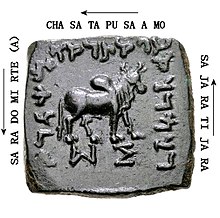
Kharosthi includes only one standalone vowel character, which is used for initial vowels in words.[citation needed]Other initial vowels use theacharacter modified by diacritics. Each syllable includes the short /a/ sound by default[citation needed],with other vowels being indicated by diacritic marks.
Long vowels are marked with the diacritic⟨𐨌⟩.Ananusvara⟨𐨎⟩indicatesnasalizationof the vowel or a nasal segment following the vowel. Avisarga⟨𐨏⟩indicates the unvoiced syllable-final /h/. It can also be used as a vowel length marker. A further diacritic, thedouble ring below⟨𐨍⟩appears with vowels -a and -u in some Central Asian documents, but its precise phonetic function is unknown.[18]
Salomon has established that the vowel order is /a e i o u/, akin to Semitic scripts, rather than the usual vowel order for Indic scripts /a i u e o/.
| Vowels | Other syllable diacritics | ||||||||
|---|---|---|---|---|---|---|---|---|---|
| diacritics | ◌
|
◌𐨅
|
◌𐨁
|
◌𐨆
|
◌𐨂
|
◌𐨃
|
𐨎
|
𐨏
| |
| short vowels | 𐨀 IPA:/ə/ a
|
𐨀𐨅 IPA:/e/ e[b]
|
𐨀𐨁 IPA:/i/ i[b]
|
𐨀𐨆 IPA:/o/ o
|
𐨀𐨂 IPA:/u/ u
|
𐨀𐨃 IPA:/r̩/ r̥
|
𐨀𐨎 aṃ
|
𐨀𐨏 aḥ
| |
| long vowels | 𐨀𐨌 IPA:/aː/ ā
|
𐨀𐨅𐨌 IPA:/ɐi̯/ ai
|
𐨀𐨁𐨌 IPA:/iː/ ī
|
𐨀𐨆𐨌 IPA:/ɐu̯/ au
|
𐨀𐨂𐨌 IPA:/uː/ ū
|
𐨀𐨃𐨌 IPA:/r̩ː/ r̥̄
|
𐨀𐨌𐨎 āṃ
|
𐨀𐨌𐨏 āḥ
| |
| examples with⟨𐨤⟩ | 𐨤 pa
|
𐨤𐨅 pe[c]
|
𐨤𐨁 pi[d]
|
𐨤𐨆 po[e]
|
𐨤𐨂 pu
|
𐨤𐨃 pr̥
|
𐨤𐨎 paṃ
|
𐨤𐨏 paḥ
| |
| examples with⟨𐨨⟩ | 𐨨 ma
|
𐨨𐨅 me
|
𐨨𐨁 mi
|
𐨨𐨆 mo
|
𐨨𐨂 mu[f]
|
𐨨𐨃 mr̥
|
𐨨𐨎 maṃ
|
𐨨𐨏 maḥ
| |
- ^There is no diacritic form of this vowel as consonants include an inherent/a/or/ə/vowel.
- ^abThe vowels⟨𐨅⟩and⟨𐨁⟩are written horizontally when combined with⟨𐨀⟩,⟨𐨣⟩,or⟨𐨱⟩
- ^The vowel⟨𐨅⟩is written vertically when combined with⟨𐨠⟩,⟨𐨤⟩,⟨𐨥⟩,or⟨𐨫⟩
- ^The vowel⟨𐨁⟩is written as a small vertical stroke when combined with⟨𐨠⟩,⟨𐨤⟩,⟨𐨥⟩,⟨𐨨⟩,⟨𐨫⟩,or⟨𐨭⟩
- ^The vowel⟨◌𐨆⟩is written vertically when combined with⟨𐨤⟩,⟨𐨥⟩,⟨𐨩⟩,or⟨𐨭⟩
- ^Combining⟨𐨨 + ◌𐨂⟩produces this unique ligature,⟨𐨡 + ◌𐨂⟩also produces a unique ligature,⟨𐨡𐨂⟩
Punctuation
[edit]Nine Kharosthi punctuation marks have been identified:[16]
𐩐 dot
|
𐩓 crescent bar
|
𐩖 danda
|
𐩑 small circle
|
𐩔 mangalam
|
𐩗 double danda
|
𐩒 circle
|
𐩕 lotus
|
𐩘 lines
|
Numerals
[edit]Kharosthi included a set of numerals that are reminiscent ofRoman numerals.[citation needed]The system is based on an additive and a multiplicative principle, but does not have the subtractive feature used in the Roman numeral system.[19]
𐩀 1
|
𐩁 2
|
𐩂 3
|
𐩃 4
|
𐩄 10
|
𐩅 20
|
𐩆 100
|
𐩇 1000
|
The numerals, like the letters, are written from right to left. There is no zero and no separate signs for the digits 5–9. Numbers are written additively, so, for example, the number 1996 would be written as𐩇𐩃𐩃𐩀𐩆𐩅𐩅𐩅𐩅𐩄𐩃𐩁.
𐩂𐩂𐩂𐩂𐩄𐩃𐩁
(2+4+10+20+20+20+20) +
𐩆𐩀𐩃𐩃
(1+4+4×100) +
𐩇
1000
Unicode
[edit]Kharosthi was added to theUnicodeStandard in March, 2005 with the release of version 4.1.
The Unicode block for Kharosthi is U+10A00–U+10A5F:
| Kharoshthi[1][2] Official Unicode Consortium code chart(PDF) | ||||||||||||||||
| 0 | 1 | 2 | 3 | 4 | 5 | 6 | 7 | 8 | 9 | A | B | C | D | E | F | |
| U+10A0x | 𐨀 | 𐨁 | 𐨂 | 𐨃 | 𐨅 | 𐨆 | 𐨌 | 𐨍 | 𐨎 | 𐨏 | ||||||
| U+10A1x | 𐨐 | 𐨑 | 𐨒 | 𐨓 | 𐨕 | 𐨖 | 𐨗 | 𐨙 | 𐨚 | 𐨛 | 𐨜 | 𐨝 | 𐨞 | 𐨟 | ||
| U+10A2x | 𐨠 | 𐨡 | 𐨢 | 𐨣 | 𐨤 | 𐨥 | 𐨦 | 𐨧 | 𐨨 | 𐨩 | 𐨪 | 𐨫 | 𐨬 | 𐨭 | 𐨮 | 𐨯 |
| U+10A3x | 𐨰 | 𐨱 | 𐨲 | 𐨳 | 𐨴 | 𐨵 | 𐨸 | 𐨹 | 𐨺 | 𐨿 | ||||||
| U+10A4x | 𐩀 | 𐩁 | 𐩂 | 𐩃 | 𐩄 | 𐩅 | 𐩆 | 𐩇 | 𐩈 | |||||||
| U+10A5x | 𐩐 | 𐩑 | 𐩒 | 𐩓 | 𐩔 | 𐩕 | 𐩖 | 𐩗 | 𐩘 | |||||||
| Notes | ||||||||||||||||
Gallery
[edit]-
Kharosthi script on a wooden plate in theNational Museum of Indiain New Delhi
-
Kharosthi script on a wooden plate in the National Museum of India in New Delhi
-
Kharosthi script on a wooden plate in the National Museum of India in New Delhi
-
Kharosthi script on wood fromNiya,3rd century CE
-
Double-wedged wooden tablet inGandhariwritten in Kharosthi script, 2nd to 4th century CE
-
Wooden tablet inscribed with Kharosthi characters (2nd–3rd century CE). Excavated at theNiyaruins inXinjiang,China. Collection of theXinjiang Museum.
-
Wooden Kharosthi document found atLoulan, ChinabyAurel Stein
-
Fragmentary Kharosthi Buddhist text on birchbark (Part of a group of early manuscripts fromGandhara), first half of 1st century CE. Collection of theBritish LibraryinLondon
-
Silver bilingualtetradrachmofMenander I(155-130 BCE).Obverse:Greeklegend, ΒΑΣΙΛΕΩΣ ΣΩΤΗΡΟΣ ΜΕΝΑΝΔΡΟΥ (BASILEOS SOTEROS MENANDROU), literally, "Of Saviour King Menander".Reverse:Kharosthi legend: MAHARAJA TRATARASA MENADRASA "Saviour King Menander".Athenaadvancing right, with thunderbolt and shield.Taxilamint mark.
-
Coin ofMenander II DikaiouObverse:Menander wearing adiadem.Greek legend: ΒΑΣΙΛΕΩΣ ΔΙΚΑΙΟΥ ΜΕΝΑΝΔΡΟΥ "King Menander the Just".Reverse:Winged figure bearing diadem and palm, withhalo,probablyNike.The Kharoshthi legend reads MAHARAJASA DHARMIKASA MENADRASA "Great King, Menander, follower of theDharma,Menander ".
-
The Indo-GreekHashtnagarPedestal symbolizesbodhisattvaand ancient Kharosthi script. Found near Rajar inGandhara,Pakistan.Exhibited at theBritish Museumin London.
-
Fragments of stone well railings with a Buddhist inscription written in Kharoshthi script (late Han period to theThree Kingdomsera). Discovered atLuoyang,China in 1924.
-
Portion of Emperor Ashoka's Rock Edicts at Shahbaz Garhi
-
Document on Wooden Stick written in Kharoshthi script, 3rd-4th century CE.
See also
[edit]Further reading
[edit]References
[edit]- ^Leitich, Keith A. (2017)."Kharoṣṭhī Script".Buddhism and Jainism.Encyclopedia of Indian Religions. Springer Netherlands. pp. 660–662.doi:10.1007/978-94-024-0852-2_238.ISBN978-94-024-0851-5.
- ^abR. D. Banerji (April 1920). "The Kharosthi Alphabet".The Journal of the Royal Asiatic Society of Great Britain and Ireland.52(2): 193–219.doi:10.1017/S0035869X0014794X.JSTOR25209596.S2CID162688271.
- ^Salomon 1998,pp. 11–13.
- ^abcdDias, Malini; Miriyagalla, Das (2007). "Brahmi Script in Relation to Mesopotamian Cuneiform".Journal of the Royal Asiatic Society of Sri Lanka.53:91–108.JSTOR23731201.
- ^Bailey, H. W. (1972). "A Half-Century of Irano-Indian Studies".Journal of the Royal Asiatic Society of Great Britain and Ireland.104(2): 99–110.doi:10.1017/S0035869X00157466.JSTOR25203366.S2CID163349913.
- ^"When these alphabets were first deciphered, scholars gave them different names such as 'Indian-Pali' for Brahmi and 'Arian-Pali' for Kharosthi, but these terms are no longer in use." inUpāsaka, Sī Esa; Mahāvihāra, Nava Nālandā (2002).History of palæography of Mauryan Brāhmī script.Nava Nālanda Mahāvihāra. p. 6.ISBN9788188242047.
- ^Kharosthi.Great Russian Encyclopedia.
- ^A Guide to Taxila, John Marshall, 1918
- ^Journal of the Asiatic Society of Bengal Vol IV 1835.pp. 327–348.
- ^Grote, Hermann (1836).Blätter für Münzkunde. Hannoversche numismatische Zeitschrift. Hrsg. von H. Grote(in German). Hahn. pp. 309–314.
- ^Salomon 1998,pp. 210–212.
- ^Richard, Salomon (2018).Buddhist Literature of Ancient Gandhara: An Introduction with Selected Translations.Simon and Schuster. p. 1.ISBN978-1-61429-185-5.
…Subsequent studies have confirmed that these and other similar materials that were discovered in the following years date from between the first century BCE and the third century CE…
- ^University of Washington."The Early Buddhist Manuscripts Project":"...These manuscripts date from the first century BCE to the third century CE, and as such are the oldest surviving Buddhist manuscripts as well as the oldest manuscripts from South Asia..." Retrieved 18 September 2021.
- ^Inscriptions of Asoka. New Edition by E. Hultzsch.1925. pp. 56–57.
- ^abDaniels, Peter T.;Bright, William,eds. (1996).The World's Writing Systems.Oxford University Press, Inc. pp. 373–383.ISBN978-0195079937.
- ^abcGlass, Andrew; Baums, Stefan; Salomon, Richard (2003-09-18)."L2/03-314R2: Proposal to Encode Kharoshthi in Plane 1 of ISO/IEC 10646"(PDF).
- ^Bopearachchi, Osmund (September 2008)."Was Indo-Greek Artemidoros the son of Indo-Sctythian Maues?".Numismatika Kronika(27): 25–36.Retrieved18 August2024.
- ^Glass, Andrew; Baums, Stefan; Salomon, Richard (2003-09-29)."L2/02-364: Proposal to add one combining diacritic to the UCS"(PDF).
- ^Graham Flegg,Numbers: Their History and Meaning,Courier Dover Publications, 2002,ISBN978-0-486-42165-0,p. 67f.

Further reading
[edit]- Dani, Ahmad Hassan (1979).Kharoshthi Primer.Lahore Museum Publication Series. Vol. 16. Lahore Museum.OCLC10695864.
{{cite book}}:CS1 maint: location missing publisher (link) - Daniels, Peter T.;Bright, William,eds. (1996).The World's Writing Systems.Oxford University Press, Inc. pp.373–383.ISBN978-0195079937.
- Falk, Harry (1993).Schrift im alten Indien: Ein Forschungsbericht mit Anmerkungen.Script Oralia (in German). Vol. 56. Tübingen: Gunter Narr.ISBN978-3-8233-4271-7.
- Fussman, Gérard. "Les premiers systèmes d'écriture en Inde".Annuaire du Collège de France 1988–1989(in French). pp. 507–514.
- von Hinüber, Oscar (1990).Der Beginn der Schrift und frühe Schriftlichkeit in Indien(in German). Franz Steiner.ISBN978-3-515-05627-4.
- Nasim Khan, M., ed. (2009).Kharoshthi Manuscripts from Gandhara(2nd ed.). Higher Education Commission of Pakistan.
- Nasim Khan, M. (2004). "Kharoshthi Manuscripts from Gandhara".Journal of Humanities and Social Sciences.XII(1–2): 9–15.
- Nasim Khan, M. (July 1999). "Two Dated Kharoshthi Inscriptions from Gandhara".Journal of Asian Civilizations.XXII(1): 99–103.
- Nasim Khan, M. (September 1997). "Kharoshthi Inscription from Swabi – Gandhara".The Journal of Humanities and Social Sciences.V(2): 49–52.
- Nasim Khan, M. (March 1997). "An Inscribed Relic-Casket from Dir".The Journal of Humanities and Social Sciences.V(1): 21–33.
- Nasim Khan, M (1997). "Ashokan Inscriptions: A Palaeographical Study".Atthariyyat.Vol. I. Peshawar. pp. 131–150.
{{cite book}}:CS1 maint: location missing publisher (link) - Norman, Kenneth R. (1992). "The development of writing in India and its effect upon the Pāli canon".Wiener Zeitschrift für die Kunde Südasiens.36:239–249.JSTOR24010823.
- Salomon, Richard (1990). "New Evidence for a Gāndhārī Origin of the Arapacana Syllabary".Journal of the American Oriental Society.110(2): 255–273.doi:10.2307/604529.JSTOR604529.
- Salomon, Richard (1 April 1993). "An additional note on Aracapana".The Journal of the American Oriental Society.113(2): 275–277.doi:10.2307/603034.JSTOR603034.GaleA14474853.
- Salomon, Richard (1998).Indian Epigraphy: A Guide to the Study of Inscriptions in Sanskrit, Prakrit, and the other Indo-Aryan Languages.Oxford University Press.ISBN978-0-19-535666-3.
- Salomon, Richard (2006). "Kharoṣṭhī syllables used as location markers in Gāndhāran stūpa architecture". In Faccenna, Domenico (ed.).Architetti, Capomastri, Artigiani: L'organizzazione Dei Cantieri E Della Produzione Artistica Nell'Asia Ellenistica: Studi Offerti a Domenico Faccenna Nel Suo Ottantesimo Compleanno.Istituto italiano per l'Africa e l'Oriente. pp. 181–224.ISBN978-88-85320-36-9.
- Salomon, Richard (1995). "On the Origin of the Early Indian Scripts".Journal of the American Oriental Society.115(2): 271–279.doi:10.2307/604670.JSTOR604670.ProQuest217141859.
External links
[edit]- Gandhari.orgCatalog and Corpus of all known Kharoṣṭhī (Gāndhārī) texts
- Indoskript 2.0,a paleographic database of Brahmi and Kharosthi
- A Preliminary Study of Kharoṣṭhī Manuscript Paleographyby Andrew Glass, University of Washington (2000)








